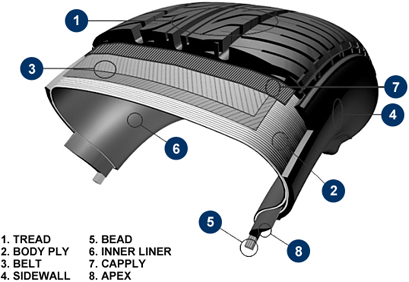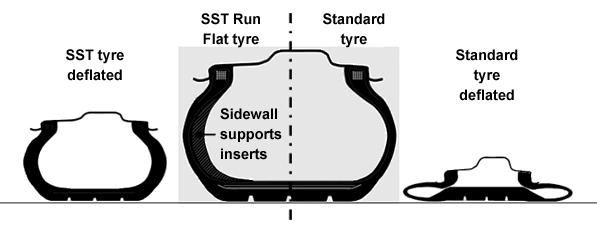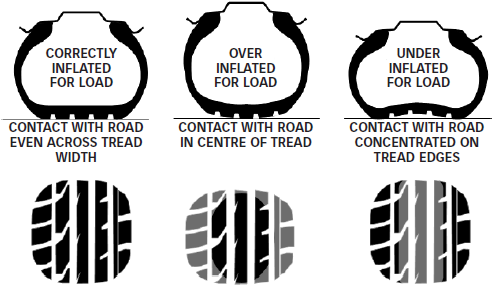Tyres are the only parts of the car which are in contact with the road. Safety in acceleration, braking, steering and cornering all depend on a relatively small area of road contact. It is therefore of paramount importance that tyres should be maintained in good condition at all times and that when the time comes to change them the correct replacements are fitted.

The original tyres for a car are determined by joint consultation between the car and tyre manufacturers and take into account all aspects of operation. It is recommended that changes in tyre size or type should not be undertaken without seeking advice from the car or tyre manufacturers, as the effect on car handling, safety and clearances must be taken into account.
In some other European countries it is illegal to use replacements which differ in certain respects (e.g. size, load, and speed rating) from the tyre fitted originally by the vehicle manufacturer.
Radial ply tyres are now the most common tyres in use on British roads representing more than 90%. Some radial ply tyres now have a run flat capability known as Self Supporting Run Flat (SST) tyres which are becoming more common particularly when fitted as an original equipment. Older diagonal (cross-) ply tyres are now very rarely seen and have effectively been replaced by radial ply tyres.
Radial ply tyres may be either steel or textile braced and are identified in the size marking by the letter "R" and often the word "Radial".
Self Supporting Run Flat (SST) tyres are designed to provide a limited run on period following a puncture. These are identified by the letters "RF" in the size marking. To be categorised as a run flat tyre, the minimum distance they must achieve in a run flat condition is 50 miles (80 km) at a maximum speed of 50 mph (80 km/h) and at a minimum of 80% of their maximum load capacity.
It is essential the vehicle is equipped with a tyre pressure monitoring system to enable use of run flat tyres.

Except in the case of temporary use spare tyres supplied as original equipment, it is illegal in the United Kingdom and dangerous to mix tyres of different types on the same axle. It is also advised that the same tyre type is fitted to all wheel positions.

Recommended tyre inflation pressures for your vehicle can be found in the vehicle handbook and/or on a placard mounted on the vehicle. In the absence of either of these consult the tyre manufacturer. Correct pressures are related to loads, speeds and vehicle handling and are vital for maximum safety, braking, grip and good tyre life.
Prolonged under-inflation causes excessive flexing, deterioration of the casing and rapid wear of the tread shoulders. The vehicle will also consume more fuel.
Over-inflation results in an uncomfortable ride, a reduced area of contact with the road, accelerated wear on the tread centre and makes the tyre more susceptible to impact damage.
Inflation pressure should be checked at least every two weeks and only when the tyre is cold, since there is an increase in pressure when the tyre has warmed up after being run.
A reliable and accurate pressure gauge should be used.
Examine your tyres regularly, removing stones and other objects embedded in the tread. If the tyre has lumps or bulges it must be examined by a tyre specialist since these could indicate internal damage. Wipe away oil or grease with a suitable diluted detergent.
Tyre treads are designed to give good grip on wet roads, but in general wet grip decreases as tyre tread pattern wears down or as the depth of water increases. Motorists should take this into consideration and reduce speed when it is wet.
The legal minimum tread depth in the UK is 1.6mm throughout a continuous band comprising the central three-quarters of the breadth of tread and round the entire outer circumference of the tyre. However tyre wet grip deteriorates more rapidly in the second half of its tread life and wet stopping distances can dramatically lengthen. It is therefore advisable consideration is given to replacing tyres well before they reach the legal minimum.